Boeing marks 50 years of 747s as Airbus A380’s future dims
As Boeing celebrates 50 years since the first test flight of its 747-100, the future of its rival, the A380, is under a cloud.

As Boeing celebrates 50 years since the first test flight of its game-changing 747-100 this weekend, the future of its Airbus rival, the A380, is under a cloud.
Comparisons between the B747 and A380 have been made since Airbus produced its mammoth superjumbo 37 years after the Boeing masterpiece.
Orders for each aircraft were scrutinised as airlines such as Singapore, Emirates and Qantas embraced the newcomer and Airbus talked up the need for bigger aeroplanes to meet growing demand for air travel into dwindling airport slots.
Alongside the gigantic, gleaming A380s, the 747s began to look dowdy and old hat.
Plane spotters flocked to photograph the distinctive A380s and passengers changed flight plans to travel on the double-decker aircraft and marvel at its quietness.
Airlines went to town on cabin design, adding stand-up bars and shower suites for premium travellers who were able to walk on to the top deck out of sight of economy class passengers.
But slowly the tide turned against the Airbus behemoth, with airlines taking the view that the aircraft was too big and unwieldy for many airports, and too expensive to buy and operate.
Malaysia Airlines withdrew its six A380s from regular service, declaring them unsuitable for its routes.

Qantas took the decision not to fill its outstanding order for another eight A380s, making the switch to Boeing’s fuel-efficient, ultra-modern 787-9 Dreamliners instead.
The Australian airline made that official this week, issuing a statement announcing that the contract with Airbus had officially been cancelled.
“These aircraft have not been part of the airline’s fleet and network plans for some time,” the statement said.
It followed confirmation from Airbus that the A380’s biggest customer, Emirates, had entered into discussions with the France-based manufacturer about its latest order.
The contract for another 20 A380s was signed in January last year and was considered a lifesaver for the aeroplane — at a time when orders had almost dried up.
Reports suggest Emirates has decided to switch its order to the smaller, more fuel-efficient A350 although neither the airline nor Airbus have confirmed this.
To date, Airbus has delivered 234 A380s to 16 customers. Almost half of those belong to Emirates, with a fleet of 109 A380s.

Singapore Airlines has 24 and Qantas, which it is about to start refurbishing with a view to operating the A380s well into the future, has 12.
In contrast, Boeing has delivered more than 1500 varieties of its 747.
Although many airlines are in the process of retiring the “Queen of the Skies”, as the 747 is known, Boeing continues to manufacture freight and passenger versions of the plane. In 2017, the US Air Force ordered two 747-8s to serve as the next presidential aircraft, Air Force One.
Qantas is continuing the process of retiring its 747s, which have dominated the airline’s international fleet since 1971. In the ensuing years, no fewer than 65 747s were bought or leased by Qantas, with just nine remaining. All of those will be retired by the end of next year.
Boeing senior corporate historian Michael Lombardi said the 747 as a freighter would be “with us for decades to come — a testament to an aeroplane that was built to last”.
The same is unlikely to be true of the A380. In a costly oversight by the designers, a cargo version of the aircraft was planned but never realised because the belly space of the A380 is less accommodating than other long-range aircraft.



